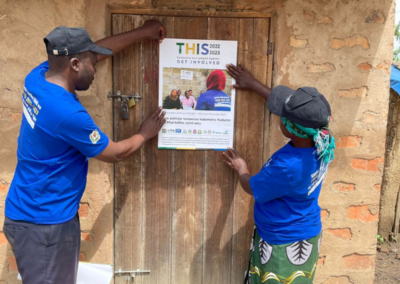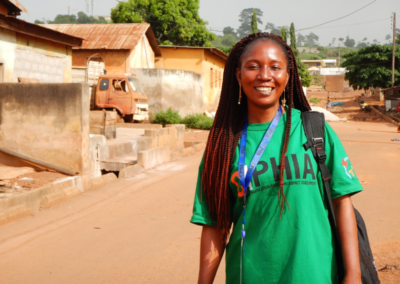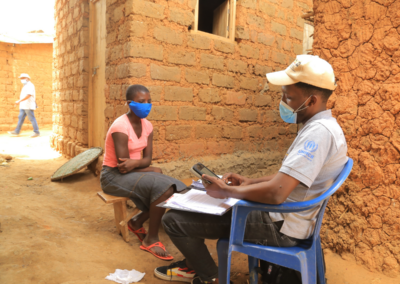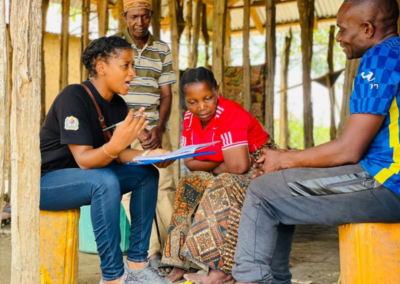Major gains in HIV epidemic control have been won in recent years – but climate change and resulting food insecurity in sub-Saharan Africa could jeopardize that progress, especially among women.
In the new article “Food insecurity and the risk of HIV acquisition: findings from population-based surveys in six sub-Saharan African countries (2016–2017)” published in BMJ, ICAP at Columbia University authors and collaborators demonstrate that severe food insecurity increases risk for HIV acquisition in women twofold.
Climate change is having a growing effect on sub-Saharan Africa. Extreme and unpredictable weather patterns, including the onset of cyclones, flooding, and drought, result in major disruptions in food production, supplies, and the delivery of already-constrained resources. Reduced rainfall is particularly distressing for a region highly dependent on rain for agricultural production. Consequential food insecurity can lead to a host of health impacts, such as increased human risk behaviors, interruptions to care, and mortality.
Assessing the complex dynamics between such household vulnerabilities as food insecurity and HIV acquisition, authors of the study used Population-based HIV Impact Assessment (PHIA) data gathered in Zambia, Eswatini, Lesotho, Uganda, Tanzania, and Namibia, surveying 112,955 adults aged 15–59. Across all countries, 23.5 percent of households reported food insecurity, with nearly half reporting severe food insecurity. Of the 14,208 HIV-positive participants, 1.9 percent were classified as having recent HIV infection, of which 140 were women and 60 were men. Severe food insecurity was associated with a twofold increase in risk of recent HIV infection in women across all countries, with no significant risk noted in men. Receipt of food support was associated with a 64 percent lower risk of recent HIV infection in women, whereas receipt of other types of support showed no effect.
“These findings suggest the gains seen in HIV epidemic control might be negatively impacted by the sharp rises in food insecurity due to COVID-19, the war in Ukraine, and other events,” said Andrea Low, MD, PhD, lead author of the study. “Women are particularly vulnerable because they are often disempowered in households or communities and have limited coping strategies.”
Across the six countries assessed, poorer households headed by women or those with many children consistently had much higher odds of severe food shortages, most likely as a result of women’s limited control over resources such as land and employment, leading to a higher susceptibility to income shocks. The increased risk of HIV acquisition may be attributed to the combination of risk factors impacting women, including a 28 percent increase in risk of engaging in transactional sex, a major driver of HIV acquisition. This study supports the findings of previous studies showing that factors that may drive poverty, like lack of education, can be associated with sex in exchange for goods.
Across all contexts, food-insecure women reported several vulnerabilities that elevate risk of HIV acquisition, including high-risk sexual behavior, more forced sex over their lifetimes, and more frequent early sexual debut. Severe food insecurity was also associated with an elevated risk of intergenerational sex, reported by 16.5 percent of young women. Women in Uganda reported the highest frequency of transactional sex, early sexual debut, and forced sex, while women in Tanzania reported more high-risk sex and intergenerational sex in young women. Economic and food support were both associated with significantly lower risks of high-risk sex.
“It’s important that we recognize that these findings are from a cross-sectional study, and so we can’t fully declare that food insecurity causes HIV acquisition,” added Low. “However, the findings are supported by many other studies, which have shown that women usually suffer more during food shortages, and some cope by engaging in higher risk sexual activity. The large sample across many countries also allowed us to really explore both HIV infection and risk behaviors and their association with food insecurity, which other studies have not been able to do.”
Based on the study’s findings, the communities with the highest levels of food insecurity also had the highest HIV prevalence. The significant association between food support and lower risk of HIV suggests that providing direct and targeted food support to women with severe food insecurity, especially amid extreme climatic events, could reduce HIV transmission. These findings also illuminate the constraints underlying poverty, including gender equity, underscoring the value of including women as change agents who can assist in understanding how to best use social assistance.
“We as a society need to assist vulnerable populations to improve their food production,” said Sam Biraro, MBChB, PhD, ICAP country representative in Uganda and an author of the study. “This will not only address the risk for HIV infection but improve people’s wellbeing more generally. Efforts must be increased to protect the environment and help to avoid extreme and unpredictable weather in order to improve food production.”
Sub-Saharan Africa’s gross domestic product is heavily dependent on weather sensitive activities – including agriculture, herding, and fishing – making the region incredibly vulnerable to climate change. Given that 20 percent of the population in sub-Saharan Africa is already undernourished, the findings of this study have serious implications for efforts to achieve or maintain global HIV epidemic control.
“We must look at the factors of climate change, food insecurity, and health as related, interconnected, and cyclical,” added Biraro. “Environmental destruction and concomitant climate change results in sub-optimal food production, which in turn, results in poor health outcomes and poverty. We must not address these issues in silos but consider food support and other support as important contributions to improving human health in the long-term, especially among women with elevated risk for HIV. This study gives us and others important context to the future of addressing HIV in the most-affected countries.”
The PHIA project is an effort is led by the Ministry of Health in each participating country and funded by the U.S. President’s Emergency Plan for AIDS Relief (PEPFAR) through the U.S. Centers for Disease Control and Prevention (CDC) with technical support from ICAP.










